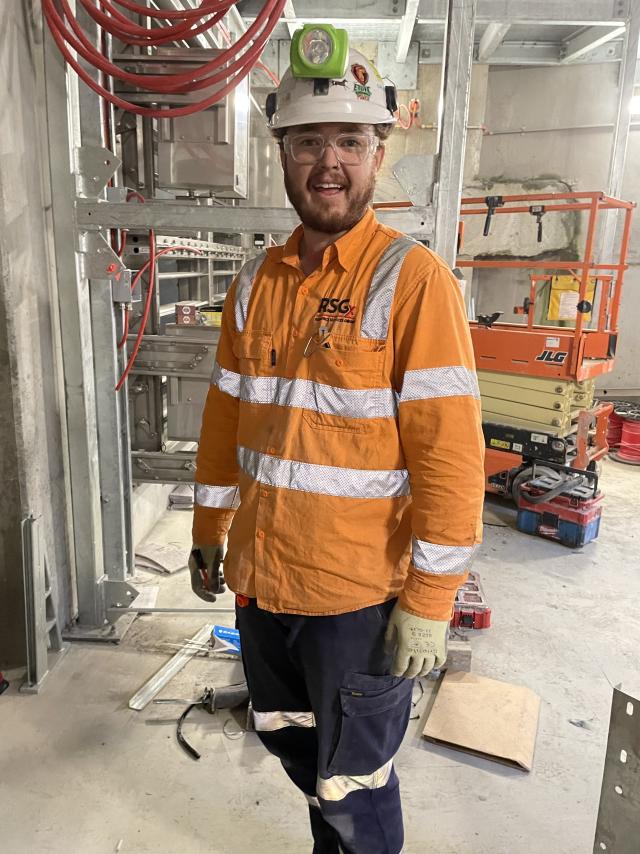(precede) August marks Tradies National Health Month (TNHM), an initiative run by the Australian Physiotherapy Association (APA) to raise awareness about the importance of tradies’ health and wellbeing. Hannah Hammoud spoke with advocates who are calling on labourers and tradespeople to be vigilant in looking after their eyes and ears on the job to avoid long term, often preventable, and in some cases irreversible, damage to their eyesight and hearing.
Optometrist Michael Angerame said each year TNHM works as a reminder for tradespeople to protect themselves from injury on the job. He said when it comes to eye and ear protection, prevention is always better than cure.
“Optometrists see a lot of tradies present that tend to have a foreign body in their eyes, either they’ve been grinding metal or using equipment without the correct safety protection for their eyes. They either have dust, metal, dirt or grit in their eyes that we have to remove,” he said.
“Optometrists are trained and we are able to remove these foreign bodies from the eye, but in some cases when we do remove it there’s still impact on the vision that can potentially be long-term depending on the extent of the injury.
“While in most cases it’s just a matter of easily removing the object from the eye and prescribing some eye drops for the eye to heal, in some cases our patients aren’t as lucky and depending on the depth of the object in the eye or the type of object it can lead to infection or a number of complications to their vision.”
In April, research from the Royal Victorian Eye and Ear Hospital revealed a concerning increase in men presenting to the emergency department with work-related eye trauma, recording a 41 per cent growth over the past five years.
Mr Angerame said this data indicates a concerning decline of awareness in preventing eye related accidents.
“These statistics show that the public is not adhering to safety procedures as much as we would like them to,” he said.
Research by Specsavers echoes these findings, revealing that younger tradies aged 18-34 are already reporting concerns over worksite damage, with 37 per cent of tradies in that age bracket incurring a workplace eye injury that required medical attention.
Yaraville electrician Matthew Garbett, 31, said that an incident he had as an apprentice where hot steel landed into his eye forced him to take his health and safety more seriously.
“I had my safety goggles on but I wasn’t wearing them correctly, they weren’t sitting properly on my face. Back then we weren’t really trained on how to wear protective equipment and people didn’t really know how to wear them right,” he said.
“Hot steel landed into my eye on the jobsite and I had to go to the eye and ear hospital to get it scratched out. There was no lasting damage but the process was painful.”
Mr Garbett said it is more often younger tradies who underestimate the importance of protective equipment.
“As you get older you take your health a bit more seriously in every aspect… you realise that you’ve only got one pair of eyes,” he said.
Mr Garbett has been an electrician for 10 years and is currently working on the Melbourne Metro Tunnel Project. He said the culture on job sites has changed and safety breaches are now strictly policed.
“If you aren’t wearing the correct safety equipment you can get reinducted and taken off site,” he said.
“On these bigger projects, you go through a series of inductions where they show you how to wear the equipment properly. So even if people don’t take it seriously they get used to wearing the equipment every time they’re on site because they have to.”
Data from the 2021 census lists technicians and trades workers as the third largest occupation sector in Victoria employing more than 399,000 Victorians.
As a working optometrist, Mr Angerame said he tends to see a higher number of incidents occurring in regional areas.
Mr Angerame said professions such as trades that are regularly exposed to risks, need to keep in mind the importance of regular eye and ear tests. Recommending people to get their eyes and ears tested every two years, or every year if they are over the age of 65.
Other top tips include:
1. Wear hearing protection when exposed to loud noise, such as earplugs, earmuffs or both.
2. Wear safety goggles to protect from debris and small bits of metal, dust, dirt or grit from getting into the eye. These can cause the eyes to water, cause redness, pain, and a scratchy sensation on the eye. This type of irritation can cause vision to become blurry or sensitive to light and can even cause damage to the cornea.
3. Wear full coverage sunglasses when working outside to protect from direct sunlight, as well as to protect from the reflective glare from machinery, buildings or the sidewalk.
4. Reduce the number of different noises at any one time, such as simultaneous conversations,
working power tools, as well as a loud radio which can place undue strain on the ears.
5. Test the noise of the working environment by using the ‘one metre rule’. If you need to raise your voice to talk to someone about one metre away, you can assume the sound level is likely to be hazardous to hearing.
National spokesperson for this year’s TNHM campaign, APA occupational health physiotherapist Lucia Tsui said the message of early intervention needs to be driven home, as it is key to stopping small issues from morphing into more serious conditions.
“Tradies put their bodies through a lot, and we want to encourage tradies to do what they can as early as possible in their career to promote longevity and keep their bodies healthy as they age,” she said.
“The pension age rose to 67 for tradies last month, which means tradies need to keep their body as healthy as possible – for longer than ever. A tradie’s body is their biggest asset, so taking care of it now will keep them healthier long into the future.”









